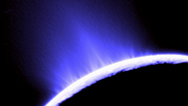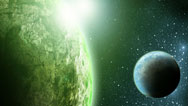Detecting Life Beyond Earth
- By Melissa Salpietra
- Posted 04.01.09
- NOVA scienceNOW
How could a scientist here on Earth know whether a planet outside our solar system, beyond the reach of spacecraft, harbored life? Harvard astrophysicist Lisa Kaltenegger describes the clues she would look for—spectroscopic "golden fingerprints" that would reveal the chemical make-up of the planet's atmosphere.
 Launch Interactive
Launch Interactive
In this video and quiz, see how scientists sniff out signs of life on distant planets, then try it yourself.
Transcript
Detecting Life Beyond Earth
Posted: April 2009
(VIDEO ONE)
NARRATOR: Finding an Earth-like planet in the far reaches of the cosmos is a difficult task. But once we've actually found one, how can we tell if there's life on it?
Luckily, scientists like Lisa Kaltenegger have ways of gauging the life-potential of a distant planet while staying right here on Earth. They do it by analyzing the planet's atmosphere. And they do that using light and heat.
LISA KALTENEGGER: A star is the only thing that actually shines itself. So it emits light. A planet usually reflects the light from the star. The light gets reflected and comes to you.
NARRATOR: The star also heats the planet, and the planet then emits this heat as infrared light. Scientists capture this infrared, invisible visible light from the spectrum, split it into separate wavelengths and chart it on a graph like this one, called a spectrum. They use this spectrum to figure out what the planet's atmosphere is made of.
LISA KALTENEGGER: If there are chemicals in the atmosphere of the planet, they absorb part of that light. So if we look at light from the planet and at a certain point there's something missing, there's an absorption feature, this is how you know what's in the atmosphere of that planet.
NARRATOR: We know that particular chemicals absorb certain wavelengths of light. Carbon dioxide, for example, absorbs specific wavelengths in the infrared spectrum, as does water, methane, ozone, and so on. By collecting light from a planet and analyzing its spectrum for missing wavelengths, we can deduce what chemicals are in the atmosphere. Which is the first step to detecting life.
(VIDEO 2)
NARRATOR: Detecting the types of chemicals in the atmosphere is the first step to finding life. But making sense of what the chemicals mean is a different ball game.
LISA KALTENEGGER: If you have a look at our own Earth, you actually have CO2, you have water, methane, and you have ozone or oxygen.
NARRATOR: So if we are searching for a planet like Earthâ¦
LISA KALTENEGGER: That's the golden fingerprint you're looking for.
NARRATOR: In the right combination, these golden fingerprint chemicals can indicate Earth-like biological activity. If we can find all of them in the atmosphere of a temperate, rocky planet, we have hit the jackpot. But a planet doesn't have to have all of these chemicals for life to exist there. Life here on Earth has changed over billions of years, and the chemicals in our atmosphere have changed with it.
LISA KALTENEGGER: If you have a look at our own Earth, you have six different kind of fingerprints, from when the Earth was really very young to where we are right now.
NARRATOR: The different chemical fingerprints the Earth has had over time, as life has evolved and changed, can guide us in our search for life on other planets. But what if life on the distant planet is completely different from anything Earth has ever harbored?
LISA KALTENEGGER: We can only go and look for something that we know how to find, as weird as that sounds. There could be a lot of life that's different from ours, and we wouldn't necessarily find it.
NARRATOR: But if we do find a planet that has an Earth-like fingerprint?
LISA KALTENEGGER: Being a scientist, I'm not gonna say there's life. But being a scientist, I'm gonna say there's all the indication that there's life and we have to investigate more.
Credits
- (bacterium)
- © istockphoto.com/Henrik Jonsson Graphic Design
- (crocodile)
- © istockphoto.com/Christoph Ermel
- (Paramecium brusaria)
- © istockphoto.com/Nancy Nehring
- (alien)
- © istockphoto.com/Dan Bailey Ltd
- (Earth with clouds)
- Courtesy NASA/Visible Earth /NASA Goddard Space Flight Center Image by Reto Stí¶ckli
- (fingerprint)
- © istockphoto.com/powerlines
- (slot machine components)
- © istockphoto.com/shellpreast
- (moon)
- © Courtesy NASA
- (comets)
- © istockphoto.com/Eratel
- (volcano)
- © istockphoto.com/limchengen
- (reef)
- © istockphoto.com/AdrianHillman
- (dinosaurs)
- © istockphoto.com/-ASI-
- (All other stills and video elements)
- © WGBH Educational Foundation
Images
Related Links
-

Alien Planets Revealed
Are we alone—and if not, what might the inhabitants of far-flung worlds look like?
-

Will We Ever Find ET?
What are the odds that smart aliens exist in the universe?
-

Ingredients for Life: Carbon
Learn why carbon is at the center of life on Earth and think about whether carbon-based life exists on other planets.
-

Detecting Life on Other Planets
Learn how scientists detect potential signs of life on distant planets.
-

Hunt for Alien Earths
Astronomers may be on the brink of finding Earth-like planets beyond our solar system.
You need the Flash Player plug-in to view this content.



